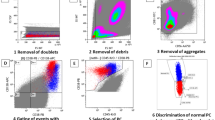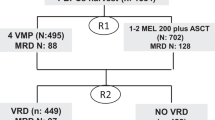Abstract
As relapses are common in acute myeloid leukemia (AML), early relapse prediction is of high importance. Although conventional minimal residual disease (MRD) measurement is carried out in bone marrow (BM), peripheral blood (PB) would be an advantageous alternative source. This study aims to investigate the specificity of leukemia-associated immunophenotypes used for MRD detection in blood samples. Consistency of PB MRD as compared with BM MRD was determined in flow cytometric data of 205 paired BM and PB samples of 114 AML patients. A significant correlation was found between PB and BM MRD (r=0.67, P<0.001), while median PB MRD percentage was factor 4-5 lower compared with BM MRD. Primitive blast (CD34+/CD117+/CD133+) frequency was significantly lower in PB (median factor 23.7), indicating that PB MRD detection is more specific than BM. Cumulative incidence of relapse 1 year after induction therapy was 29% for PB MRD-negative and 89% for PB MRD-positive patients (P<0.001). Three-year OS was 52% for MRD-negative and 15% for MRD-positive patients (P=0.034). Similar differences were found after consolidation therapy. As PB MRD appeared to be an independent predictor for response duration, the highly specific PB MRD assay may have a prominent role in future MRD assessment in AML.
This is a preview of subscription content, access via your institution
Access options
Subscribe to this journal
Receive 12 print issues and online access
$259.00 per year
only $21.58 per issue
Buy this article
- Purchase on Springer Link
- Instant access to full article PDF
Prices may be subject to local taxes which are calculated during checkout



Similar content being viewed by others
References
Pabst T, Vellenga E, van Putten W, Schouten HC, Graux C, Vekemans M-C et al. Favorable effect of priming with granulocyte colony-stimulating factor in remission induction of acute myeloid leukemia restricted to dose escalation of cytarabine. Blood 2012; 119: 5367–5373.
Cheson BD, Bennett JM, Kopecky KJ, Büchner T, Willman CL, Estey EH et al. Revised recommendations of the International Working Group for Diagnosis, Standardization of Response Criteria, Treatment Outcomes, and Reporting Standards for Therapeutic Trials in Acute Myeloid Leukemia. J Clin Oncol 2003; 21: 4642–4649.
Freeman SD, Virgo P, Couzens S, Grimwade D, Russell N, Hills RK et al. Prognostic relevance of treatment response measured by flow cytometric residual disease detection in older patients with acute myeloid leukemia. J Clin Oncol 2013; 31: 4123–4131.
Terwijn M, van Putten WL, Kelder A, van der Velden VH, Brooimans RA, Pabst T et al. High prognostic impact of flow cytometric minimal residual disease detection in acute myeloid leukemia: data from the HOVON/SAKK AML 42 A study. J Clin Oncol 2013; 31: 3889–3897.
Shayegi N, Kramer M, Bornhauser M, Schaich M, Schetelig J, Platzbecker U et al. The level of residual disease based on mutant NPM1 is an independent prognostic factor for relapse and survival in AML. Blood 2013; 122: 83–92.
Krönke J, Schlenk RF, Jensen K-O, Tschürtz F, Corbacioglu A, Gaidzik VI et al. Monitoring of minimal residual disease in NPM1-mutated acute myeloid leukemia: a study from the German-Austrian acute myeloid leukemia study group. J Clin Oncol 2011; 29: 2709–2716.
Guerrasio A, Pilatrino C, De Micheli D, Cilloni D, Serra A, Gottardi E et al. Assessment of minimal residual disease (MRD) in CBFbeta/MYH11-positive acute myeloid leukemias by qualitative and quantitative RT-PCR amplification of fusion transcripts. Leukemia 2002; 16: 1176–1181.
Sugimoto T, Das H, Imoto S, Murayama T, Gomyo H, Chakraborty S et al. Quantitation of minimal residual disease in t(8;21)-positive acute myelogenous leukemia patients using real-time quantitative RT-PCR. Am J Hematol 2000; 64: 101–106.
Mitterbauer G, Zimmer C, Pirc-Danoewinata H, Haas OA, Hojas S, Schwarzinger I et al. Monitoring of minimal residual disease in patients with MLL-AF6-positive acute myeloid leukaemia by reverse transcriptase polymerase chain reaction. Br J Haematol 2000; 109: 622–628.
San Miguel JF, Martínez A, Macedo A, Vidriales MB, López-Berges C, González M et al. Immunophenotyping investigation of minimal residual disease is a useful approach for predicting relapse in acute myeloid leukemia patients. Blood 1997; 90: 2465–2470.
Díez-Campelo M, Pérez-Simón JA, Pérez J, Alcoceba M, Richtmon J, Vidriales B et al. Minimal residual disease monitoring after allogeneic transplantation may help to individualize post-transplant therapeutic strategies in acute myeloid malignancies. Am J Hematol 2009; 84: 149–152.
Venditti A, Buccisano F, Del Poeta G, Maurillo L, Tamburini A, Cox C et al. Level of minimal residual disease after consolidation therapy predicts outcome in acute myeloid leukemia. Blood 2000; 96: 3948–3952.
Kern W, Voskova D, Schoch C, Hiddemann W, Schnittger S, Haferlach T . Determination of relapse risk based on assessment of minimal residual disease during complete remission by multiparameter flow cytometry in unselected patients with acute myeloid leukemia. Blood 2004; 104: 3078–3085.
Feller N, van der Pol MA, van Stijn A, Weijers GW, Westra AH, Evertse BW et al. MRD parameters using immunophenotypic detection methods are highly reliable in predicting survival in acute myeloid leukaemia. Leukemia 2004; 18: 1380–1390.
Al-Mawali A, Gillis D, Lewis I . The use of receiver operating characteristic analysis for detection of minimal residual disease using five-color multiparameter flow cytometry in acute myeloid leukemia identifies patients with high risk of relapse. Cytometry B Clin Cytom 2009; 76: 91–101.
Buccisano F, Maurillo L, Spagnoli A, Del Principe MI, Ceresoli E, Lo Coco F et al. Monitoring of minimal residual disease in acute myeloid leukemia. Curr Opin Oncol 2009; 21: 582–588.
Vidriales MB, San-Miguel JF, Orfao A, Coustan-Smith E, Campana D . Minimal residual disease monitoring by flow cytometry. Best Pract Res Clin Haematol 2003; 16: 599–612.
Brisco MJ, Sykes PJ, Hughes E, Dolman G, Neoh SH, Peng LM et al. Monitoring minimal residual disease in peripheral blood in B-lineage acute lymphoblastic leukaemia. Br J Haematol 1997; 99: 314–319.
Van Rhee F, Marks DI, Lin F, Szydlo RM, Hochhaus A, Treleaven J et al. Quantification of residual disease in Philadelphia-positive acute lymphoblastic leukemia: comparison of blood and bone marrow. Leukemia 1995; 9: 329–335.
Van der Velden VH, Jacobs DC, Wijkhuijs AJ, Comans-Bitter WM, Willemse MJ, Hählen K et al. Minimal residual disease levels in bone marrow and peripheral blood are comparable in children with T cell acute lymphoblastic leukemia (ALL), but not in precursor-B-ALL. Leukemia 2002; 16: 1432–1436.
Coustan-Smith E, Sancho J, Hancock ML, Razzouk BI, Ribeiro RC, Rivera GK et al. Use of peripheral blood instead of bone marrow to monitor residual disease in children with acute lymphoblastic leukemia. Blood 2002; 100: 2399–2402.
Maurillo L, Buccisano F, Spagnoli A, Del Poeta G, Panetta P, Neri B et al. Monitoring of minimal residual disease in adult acute myeloid leukemia using peripheral blood as an alternative source to bone marrow. Haematologica 2007; 92: 605–611.
Van der Velden VH, van der Sluijs-Geling A, Gibson BE, te Marvelde JG, Hoogeveen PG, Hop WC et al. Clinical significance of flowcytometric minimal residual disease detection in pediatric acute myeloid leukemia patients treated according to the DCOG ANLL97/MRC AML12 protocol. Leukemia 2010; 24: 1599–1606.
Grimwade D, Hills RK, Moorman AV, Walker H, Chatters S, Goldstone AH et al. Refinement of cytogenetic classification in acute myeloid leukemia: determination of prognostic significance of rare recurring chromosomal abnormalities among 5876 younger adult patients treated in the United Kingdom Medical Research Council trials. Blood 2010; 116: 354–365.
Feller N, van der Velden VH, Brooimans RA, Boeckx N, Preijers F, Kelder A et al. Defining consensus leukemia-associated immunophenotypes for detection of minimal residual disease in acute myeloid leukemia in a multicenter setting. Blood Cancer J 2013; 3: e129.
Metz CE . Basic principles of ROC analysis. Semin Nucl Med 1978; 8: 283–298.
Paietta E . Minimal residual disease in acute myeloid leukemia: coming of age. Hematology Am Soc Hematol Educ Program 2012; 2012: 35–42.
Buccisano F, Maurillo L, Del Principe MI, Del Poeta G, Sconocchia G, Lo-Coco F et al. Prognostic and therapeutic implications of minimal residual disease detection in acute myeloid leukemia. Blood 2012; 119: 332–341.
Schuurhuis GJ, Ossenkoppele G . Minimal residual disease in acute myeloid leukemia: already predicting a safe haven? Expert Rev Hematol 2010; 3: 1–5.
Boeckx N, De Roover J, van der Velden VH, Maertens J, Uyttebroeck A, Vandenberghe P et al. Quantification of CBFB-MYH11 fusion gene levels in paired peripheral blood and bone marrow samples by real-time PCR. Leukemia 2005; 19: 1988–1990.
Leroy H, de Botton S, Grardel-Duflos N, Darre S, Leleu X, Roumier C et al. Prognostic value of real-time quantitative PCR (RQ-PCR) in AML with t(8;21). Leukemia 2005; 19: 367–372.
Stentoft J, Hokland P, Ostergaard M, Hasle H, Nyvold CG . Minimal residual core binding factor AMLs by real time quantitative PCR—initial response to chemotherapy predicts event free survival and close monitoring of peripheral blood unravels the kinetics of relapse. Leuk Res 2006; 30: 389–395.
Cilloni D, Renneville A, Hermitte F, Hills RK, Daly S, Jovanovic JV et al. Real-time quantitative polymerase chain reaction detection of minimal residual disease by standardized WT1 assay to enhance risk stratification in acute myeloid leukemia: a European LeukemiaNet study. J Clin Oncol 2009; 27: 5195–5201.
Cilloni D, Messa F, Arruga F, Defilippi I, Gottardi E, Fava M et al. Early prediction of treatment outcome in acute myeloid leukemia by measurement of WT1 transcript levels in peripheral blood samples collected after chemotherapy. Haematologica 2008; 93: 921–924.
Cribe AS, Steenhof M, Marcher CW, Petersen H, Frederiksen H, Friis LS . Extramedullary disease in patients with acute myeloid leukemia assessed by 18 F-FDG PET. Eur J Haematol 2013; 90: 273–278.
Terwijn M, Kelder A, Snel a N, Rutten AP, Scholten WJ, Oussoren YJ et al. Minimal residual disease detection defined as the malignant fraction of the total primitive stem cell compartment offers additional prognostic information in acute myeloid leukaemia. Int J Lab Hematol 2012; 34: 432–441.
Bachas C, Schuurhuis GJ, Assaraf YG, Kwidama ZJ, Kelder A, Wouters F et al. The role of minor subpopulations within the leukemic blast compartment of AML patients at initial diagnosis in the development of relapse. Leukemia 2012; 26: 1313–1320.
Terwijn M, Zeijlemaker W, Kelder A, Rutten AP, Snel AN, Scholten WJ et al. Leukemic stem cell frequency: a strong biomarker for clinical outcome in acute myeloid leukemia. PLoS One 2014; 9: e107587.
Ostronoff F, Othus M, Lazenby M, Estey E, Appelbaum FR, Evans A et al. Prognostic significance of NPM1 mutations in the absence of FLT3-internal tandem duplication in older patients with acute myeloid leukemia: a SWOG and UK National Cancer Research Institute/Medical Research Council report. J Clin Oncol 2015; 33: 1157–1164.
Amadori S, Suciu S, Stasi R, Salih HR, Selleslag D, Muus P et al. Sequential combination of gemtuzumab ozogamicin and standard chemotherapy in older patients with newly diagnosed acute myeloid leukemia: results of a randomized phase III trial by the EORTC and GIMEMA consortium (AML-17). J Clin Oncol 2013; 31: 4424–4430.
Clozel T, Renneville A, Venot M, Gardin C, Kelaidi C, Leroux G et al. Slow relapse in acute myeloid leukemia with inv(16) or t(16;16). Haematologica 2009; 94: 1466–1468.
Acknowledgements
We would like to thank ZJ Kwidama for her help in data acquisition and data analysis.
Author information
Authors and Affiliations
Corresponding author
Ethics declarations
Competing interests
The authors declare no conflict of interest.
Additional information
Supplementary Information accompanies this paper on the Leukemia website
Supplementary information
Rights and permissions
About this article
Cite this article
Zeijlemaker, W., Kelder, A., Oussoren-Brockhoff, Y. et al. Peripheral blood minimal residual disease may replace bone marrow minimal residual disease as an immunophenotypic biomarker for impending relapse in acute myeloid leukemia. Leukemia 30, 708–715 (2016). https://doi.org/10.1038/leu.2015.255
Received:
Revised:
Accepted:
Published:
Issue Date:
DOI: https://doi.org/10.1038/leu.2015.255
This article is cited by
-
Measurable residual disease (MRD)-testing in haematological and solid cancers
Leukemia (2024)
-
Impact of hemodilution on flow cytometry based measurable residual disease assessment in acute myeloid leukemia
Leukemia (2024)
-
Association of hematologic response and assay sensitivity on the prognostic impact of measurable residual disease in acute myeloid leukemia: a systematic review and meta-analysis
Leukemia (2022)
-
Use of Minimal Residual Disease in Acute Myeloid Leukemia Therapy
Current Treatment Options in Oncology (2020)
-
Peripheral blood minimal/measurable residual disease assessed in flow cytometry in acute myeloblastic leukemia
Leukemia (2019)



